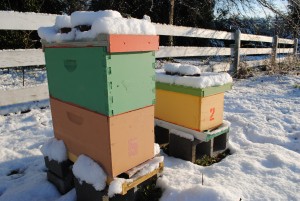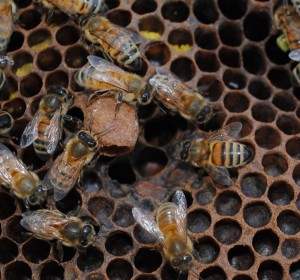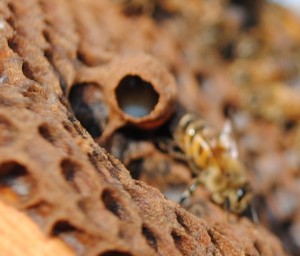
Beekeeping in Richmond, Virginia continues to be an adventure full of surprises. Last week, we rose into the lower 60’s – the weekend comes and we get 3 inches of snow! Ha! Although the snow was fun (I really didn’t think we had a chance of snow at this point, its been so warm), it was interesting to see that not a single hive or nuc had chill brood. They must be doing something right!
To add to the craziness, 3 days later it rose into the 70’s!! This was a real boon, as it afforded me the opportunity to open up a bunch of hives to see what was going on.
I started off at the Westover hives. I am constantly interested in the hive that was knocked over in Hurricane Irene last year. I found it, about noon on Sunday after the full brunch of the hurricane had hit us on Saturday. The bottom board (screened) was laying across the yard. The bottom hive body was literally on its side and the top hive body (and one honey super) were laying flat on the ground nearby. Bees were thick in the lower hive body (where I figured the queen must be) and had been able to escape robbing because of all of the leaves and tree limbs that sheltered them. I put them back together, leveled the hive and let ’em roll, not sure what would happen. After checking today, it didn’t set them back a bit.

Most hives averaged around 5.5 frames of brood. Nearly all patterns ranked from 8 to 10, with one 2 (this one looked like a failing queen) and one 5. I found one hive with 9 frames of brood – they will be the parent to my first Nucs next wekeend, if things hold out. Honey stores were great in all of the hives (I checked 9 full hives) but one. I did find a hive that was laying brood in the upper Medium, although the bottom Deep was full of honey (except for an empty area about the size of a baseball (maybe bigger) where they had laid brood at one time or another. Most folks would reverse this hive, but I purposefully let them alone just to see. I have my doubts about ‘reversing’, based on some readings of Brother Adam, so I thought I would run my first primitive experiment.
I also found where a couple of hives were drawing was and/or storing some nectar in the brood nest. For some, the latter is a sign of swarm prep. I marked those hives for another check this weekend (and probably next weekend.) I was surprised to see the wax draw – it was more then just a little. I do not recall how warm it has to be to draw wax, but I definitely didn’t think it had gotten that warm. I am clearly wrong, so probably need to read up on those stats again.
All in all, a good inspection day. For the most part, it was ‘good’ because I am no longer wondering what’s going on in those hives. But, that is a perfect opportunity for me to get on my soap box and espouse about my thoughts on early inspections!!! Depending on their goals, beekeepers have different reasons for going into the hives at this time of year. Most beekeepers (the newer ones) should have the simple goal of ‘what’s going on in there’ as a learning experience. As a basic ‘to do’ list, you go in to check the brood pattern, find drones, check honey stores (probably most important) and look for any signs of problems. I typically dissuade any of the 2nd year beekeepers that I mentor from going into the hives too early, as I would hate for them to accidentally kill their queen when no drones were about. I found one hive with so many drones this past week that I am confident that killing a queen right now is no longer a death sentence.

Case in point, one thing that everyone should be doing right now is checking brood pattern. It is particularly hard to do as a new beekeeper with one hive. But, you need to do it. ‘Pattern’ typically refers to two things. 1 (and both easy to assess and least important), how much of the frame does it take up. 2, how ‘spotty’ is the pattern. This one is more difficult, but very important. A queen should start laying in the center of a frame and work outwards, in a concentric circle. In the end, every single cell should receive an egg (until she stops building the circle – which might be small or large – not a sign of queen health, but a sign of how many nurse bees are about.) When they cap the eggs, you have a smooth, flawless circle of capped brood. Sometimes, the bees notice something wrong with a capped pupae and extract it, expelling it from the hive (many yards away.) This creates a small hole in the ‘brood pattern’. For me, a few holes is fine – I view it as good genes – they found pupae with varroa and removed the pupae, preventing or reducing the varroa cycle. But, if you find a lot of holes, it can mean that the queen is laying dud eggs. It’s definitely a problem, as these are all potential population for your hive and it probably means the queen was either poorly mated or is failing.
As it so happens, the very last hive that I inspected the other day had a very poor brood pattern and not nearly the amount of frames of brood that I consider healthy right now. I was debating on whether to kill my queen when I discovered that the bees were taking care of it! Right there on the comb was a queen cell! It hadn’t been capped yet, so I was actually able to see the mass of royal jelly they had put around the larva (hard to see in the pic)! Although I don’t mind killing a queen, I much prefer the natural process (my number one hive – 9 frames of brood and enough drones on the comb to fill up a nuc!) came from a queen raised by the bees in March last year. I believe in the process, so I was glad to see the bees taking action. The wild thing is that this was my meanest (most defensive) hive last year – I went in to kill queen multiple times in July/August, but could never find her. But, these bees were by far the most gentle bees that I opened on this day. Hard to say why this was (the old queen was still there). Maybe the prospect of a new queen had everyone in a good mood=)
In conclusion, the bees are really ahead of schedule this year, as everyone thought they’d be. I still plan to start a few Nucs next weekend, so more on that later.

Reader Comments
Hi,
I noticed that the pictures in this post are referencing the old URL. Maybe you can change it?
Besides that, as a new beekeeper I really enjoy your blog. Keep the articles coming!
Thanks, man. I will fix that now.